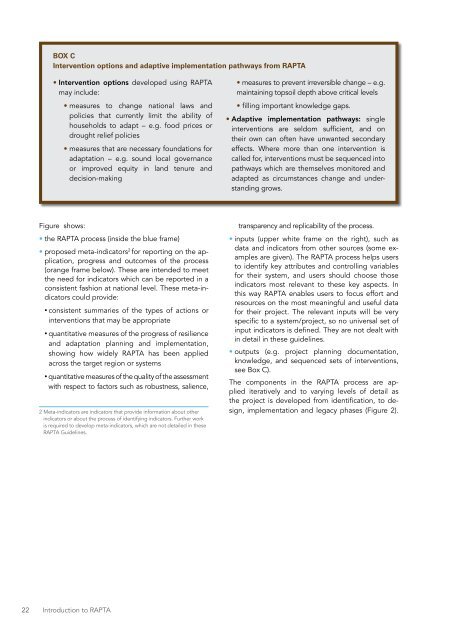DESIGNING PROJECTS IN A RAPIDLY CHANGING WORLD
srun3013fp1
srun3013fp1
You also want an ePaper? Increase the reach of your titles
YUMPU automatically turns print PDFs into web optimized ePapers that Google loves.
BOX C<br />
Intervention options and adaptive implementation pathways from RAPTA<br />
• Intervention options developed using RAPTA<br />
may include:<br />
• measures to change national laws and<br />
policies that currently limit the ability of<br />
households to adapt – e.g. food prices or<br />
drought relief policies<br />
• measures that are necessary foundations for<br />
adaptation – e.g. sound local governance<br />
or improved equity in land tenure and<br />
decision-making<br />
• measures to prevent irreversible change – e.g.<br />
maintaining topsoil depth above critical levels<br />
• filling important knowledge gaps.<br />
• Adaptive implementation pathways: single<br />
interventions are seldom sufficient, and on<br />
their own can often have unwanted secondary<br />
effects. Where more than one intervention is<br />
called for, interventions must be sequenced into<br />
pathways which are themselves monitored and<br />
adapted as circumstances change and understanding<br />
grows.<br />
Figure shows:<br />
• the RAPTA process (inside the blue frame)<br />
• proposed meta-indicators 2 for reporting on the application,<br />
progress and outcomes of the process<br />
(orange frame below). These are intended to meet<br />
the need for indicators which can be reported in a<br />
consistent fashion at national level. These meta-indicators<br />
could provide:<br />
• consistent summaries of the types of actions or<br />
interventions that may be appropriate<br />
• quantitative measures of the progress of resilience<br />
and adaptation planning and implementation,<br />
showing how widely RAPTA has been applied<br />
across the target region or systems<br />
• quantitative measures of the quality of the assessment<br />
with respect to factors such as robustness, salience,<br />
2 Meta-indicators are indicators that provide information about other<br />
indicators or about the process of identifying indicators. Further work<br />
is required to develop meta-indicators, which are not detailed in these<br />
RAPTA Guidelines.<br />
transparency and replicability of the process.<br />
• inputs (upper white frame on the right), such as<br />
data and indicators from other sources (some examples<br />
are given). The RAPTA process helps users<br />
to identify key attributes and controlling variables<br />
for their system, and users should choose those<br />
indicators most relevant to these key aspects. In<br />
this way RAPTA enables users to focus effort and<br />
resources on the most meaningful and useful data<br />
for their project. The relevant inputs will be very<br />
specific to a system/project, so no universal set of<br />
input indicators is defined. They are not dealt with<br />
in detail in these guidelines.<br />
• outputs (e.g. project planning documentation,<br />
knowledge, and sequenced sets of interventions,<br />
see Box C).<br />
The components in the RAPTA process are applied<br />
iteratively and to varying levels of detail as<br />
the project is developed from identification, to design,<br />
implementation and legacy phases (Figure 2).<br />
22 Introduction to RAPTA


